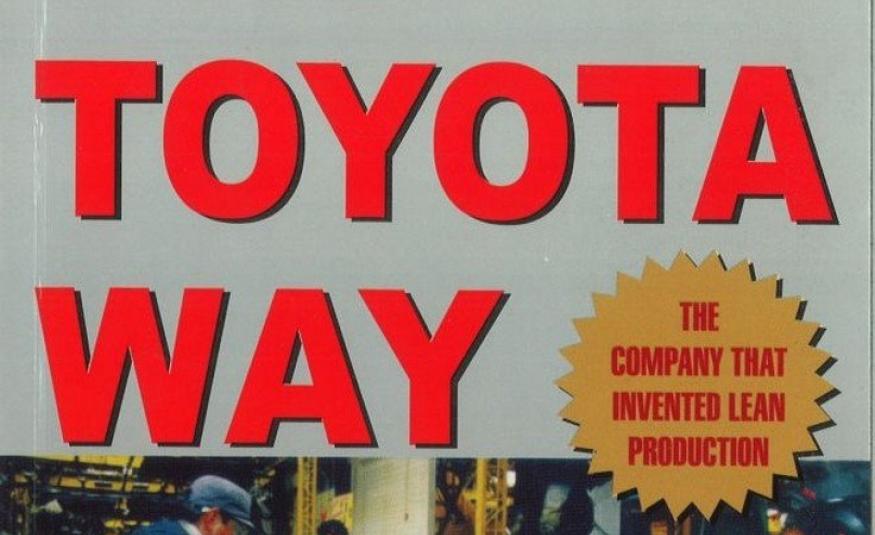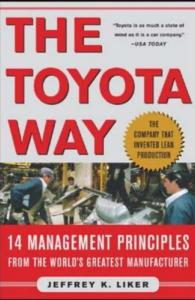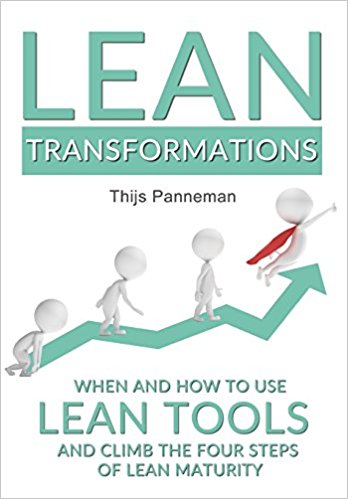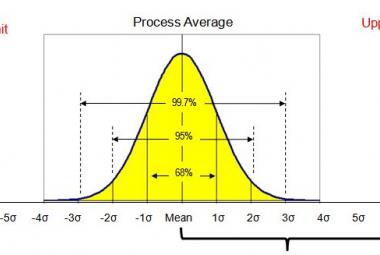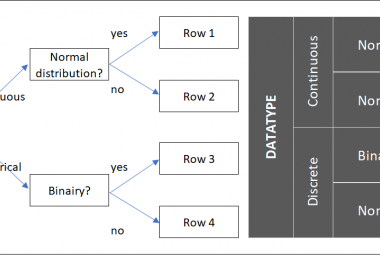‘The Toyota way’ by Jeffrey K. Liker is about Toyota’s unique approach to Lean Management. To create a learning enterprise, Liker describes 14 management principles an organization should embrace. These 14 principles are divided and discussed using a 4P model: Philosophy, Process, People & Partners and Problem Solving. This article will focus on the second part of the book, in which each of the four P’s are described in a section with the underlying principles that fit within that category. The 14 principles are shortly described at the end of this article.
I would recommend this book to all managers who want to change their organization into a Lean organization. Liker explains that the worldly known Toyota Production System (TPS) is not only about the tools, which fit only the Process part of the 4P model, but also about culture. Without going in to much detail on how the organization should facilitate change, Liker describes very clearly what should be done in order to succeed. It is also one of the greatest influencers on my own book, Lean Transformations, which explains how each of the lean tools can be linked to the 14 Toyota Principles described in this book, to make them work for you as a company (Panneman, 2017)
Students with a technical background should read this book because it elaborates on why the Lean tools that are taught during educational programs are developed and the organizational philosophy that is necessary for the tools to be effective.
The First P stands for PHILOSOPHY. Liker describes the first principle of the Toyota way in this section: the long term Philosophy. The mission of a company should never be focused on making money or KPI performance (short term) but should consist of three parts: contribute to the growth of the economy (1), contribute to the well being of employees (2) and contribute to the growth of the company (3). Making money is just a requirement to achieve these three. The message send by the leaders of Toyota are also based on this principle, which is: ‘sustainable growth can only be achieved by Doing the right thing for the company, its employees, the customer and society as a whole’.
Section two, PROCESS, consists of seven management principles (principles 2 to 8) all related to the technical side of Lean manufacturing: process optimization. According to Liker, this is where most companies focus on when implementing Lean. Neglecting the other three P’s is also the main reason why many companies fail to become a Lean organization. Most Lean tools are focused on the reduction of waste (Muda). However Toyota also uses two other areas of focus: ‘overburdening of machines & people’ (Muri) and ‘Unevenness’ (Mura). For instance, reducing wastes by implementing flow (principle 2) is much easier when the production schedule is balanced (principle 4) because you remove the variation from production demand. An unbalanced production flow can lead to overburdening your machines or people, which in turn may lead to downtimes or prevent your people from improving their processes. The foundation for continuous improvement according to Liker is principle 6: working with standards. When all employees do a certain task the same way which is documented in a detailed task description, it is easy to start a discussion on how to improve a small part of that working cycle. All incremental improvements are captured in the standard operation procedure to make sure the improvement is documented and communicated throughout the operators.
In Section three, PEOPLE & PARTNERS, three principles (9-11) are described. For sustainable long term growth you need to invest in your people and partners. Internally grown leaders prevent radical management philosophy changes on plant level, all employees should be empowered and participate in continuous improvement and the organization should challenge and work together with its suppliers and partners to optimize the supply chain. Bottom line: people are your most valuable asset. Without them, the tools described in principle 2-8 simply will not work.
The fourth P stands for PROBLEM SOLVING, which is crucial if you want to become a learning organization. Consensus is an important part in implementing improvements in any process. Without consensus of the team members, the new way of working will not work. It is important to include operators in solving problems, at the Gemba where the problem occurs and not in an office behind a screen. All problems should be process based – not results based.
THE 14 TOYOTA WAY MANAGEMENT PRINCIPLES:
Principle 1: Base your decisions on a Long-Term Philosophy This principle is the foundation of all other principles and is incorporated in Toyota’s mission: to do the right thing for the company, it’s employees, the customer, and society as a whole.
Principle 2 create Continuous Flow. Flow is a way in which all types of waste defined by Ohno (1988) are brought to the surface. By implementing one-piece-flow, the optimal process, inventories between operations are reduced that hide problems at upstream operations. Quality errors are detected earlier in one-piece flow which reduce the amount of scrap work.
Principle 3: use Pull systems to avoid overproduction. Unfortunately, not every part of the process can be done one-piece flow. For example, it would not be efficient for a supplier to deliver one bolt each delivery. But it would also not be efficient if the truck would be filled with as many bolts as possible at every delivery. The next best thing according to Liker is a pull system, like kanban. The philosophy is that one should only deliver material exactly when it is needed.
Principle 4: level out the workload Heijunka, to reduce the unevenness. Making the same amount of different products each interval has multiple benefits over producing one type of product as long as possible to reduce changeovers. Apart from reducing the risk of unsold products and being more flexible producing at customer demand, leveling out the workload creates a balanced use of labor and machines, and a smooth demand of upstream processes and suppliers.
Principle 5: Stop and fix the problem To build quality, a method to detect defects when they occur and automatically stop production should be in place (Jidoka). It is better to stop production and fix the problem at the root cause, than to continue production at the risk of creating more defects.
Principle 6: work with standards Standard work consists of takt time, a work sequence and a standard amount of stock at hand. When every employee does the task the same way, it is easier to improve that one best way.
Principle 7: Make problems visual The 5S system (Sort, Straighten, Shine, Standardize and Sustain) can be seen as a continuous process of improving the working environment as well as a just-in-time system for information flow.
Principle 8 Use only reliable tested technology
Principle 9: Grow your leaders internally It is important for the company to grow the next generation of leaders internally to make sure they embrace the same Philosophy as the current leaders. Internal grown leaders have more in dept knowledge of the work done in the organization and should be trained to be a facilitating manager, coaching the employees in his or her team.
Principle 10: Develop exceptional people and teams Promote team work and make sure the teams do things instead of talk about things. The team lead should be a facilitator of his team. Because all team members participate in continuous improvements, the standard work does not dissatisfy operators but supports growth towards self-actualization (Maslows pyramid).
Principle 11: Respect your Network partners Work together with your partners, focus on long term partnership and grow to common goals together. Liker describes the Supply Chain Need hierarchy where you first need a stable relationship with your partners before you can become a learning organization. One cannot optimize the supply chain if the business relationships are unfair, unreliable or when expectations are unclear.
Principle 12: Go see for yourself Never base decisions on data from your screen, but always go to the Gemba (shopfloor) to see the problem for yourself and talk with the operators who encounter the problem and facilitate them in fixing it. Liker also mentions: as a leader, a call from the shop floor is more important than a call from top management.
Principle 13: Make decisions slowly by consensus and implement rapidly without consensus of the people who work at the shop floor, they will never use the tools you implement according to principle 2-8. For each problem: go to Gemba, include all team members, and investigate all possible solutions. According to Liker, the A3 form can be the key tool be used at creating consensus on complex decisions.
Principle 14: Use Hansei (reflection) and Continuous Improvement (Kaizen) to become a Learning Organization Growth is only possible when you take time to reflect (Hensei) on performance, perform a root cause analysis on problems (5x Why) and implement proper countermeasures (improvements; Kaizen) to prevent the problem from reoccurring. Take time to define the real problem by focusing on the process, not the results. Use the plan-do-check-act cycle (PDCA) to solve your problems.
DISCUSSION ON LONG VS SHORT TERM KPI
Liker’s first principle describes that focus should only be put on the long-term goals and in the explaining principal 14 he argues that measuring results on the short term is undesirable. Instead, KPI’s should be both process oriented, and long term. A definition of short term is not given in The Toyota Way.
Ohno (1988) also describe the use of Long term KPI’s to track performance of your production environment. In his book The Toyota Production System he stresses the use of focusing on time rather than capacity. Lead time can be split in three types of time; processing time, waiting time and transport time. In a low volume and high variety production environment, reducing lead times for a product or product family is considered a long term goal. Focusing on the lead time is therefore considered process-focused and long term, and is therefore in line with Liker’s principle.
On the other hand, Kotter (1996) describes eight steps to transforming your organization in his work Leading Change of which one critical step is to generate short term gains. Kotter encourages the measurement of results on a short term because short term wins are essential to keep the employees motivated to continue with the new way of working. He also describes short term wins should be measurable between 12 and 24 months after starting the cultural change while real cultural change will take at least 5-8 years.
Suzaki (1993) also describes the need to track short term KPI’s on the shop floor to facilitate continuous improvement. In his book The New Shop Floor Management he encourages the use of communication cells at each department to facilitate communication between departments and between shifts within the department. The KPI’s tracked on the board should also lead to direct action when the performance is below target, to prevent escalation. By focusing only on long term KPI’s, small problems might only be noticed after a certain period of time, leading to defects.
I would therefore personally use both short term KPI’s and Long term KPI’s. The short term KPI’s should be used at the shop floor to facilitate a quick response when problems occur (suzaki, 1993), which can also be used to show results of the Lean initiatives to motivate employees (Kotter, 1996). The focus of management should be on the long term process KPI’s (Liker, 2004), which to track process changes in Lead time, Transport times and waiting times (Ohno, 1988).
The main message Liker sends is that technical tools in production only work when the organization culture facilitates these tools. Management should live by the long term philosophy of being supportive to the people they are leading and should be recruited internally so they can combine their leadership skills with in-depth knowledge of the work done in the organization. Employees at all levels of the organization should be trained in problem solving and be involved in all implementation of tools in the production environment to reach consensus on the new way of working.
Continue to:
The Lean Manager - F.Ballé & M.Ballé (summary)
REFERENCES:
Ohno, T, 1988, Toyota Production System: Beyond Large Scale Production, Cambridge, MA: Productivity press (order this book)
Kotter, J, 1996, Leading Change, Boston, MA: Harvard Business School Suzaki, K., 1993, The New Shop Floor Management, empowering people for continuous improvement New York : Free Press, (summary / order this book)
Liker, J., 2004, The Toyota Way, 14 management principles from the world greates manufacturer New York: Mc-Graw Hill (summary / order this book)
Panneman, T, 2017, Lean Transformations - when and how to climb the four steps of Lean maturity, Maarssen (NL): panview (summary / order this book)

